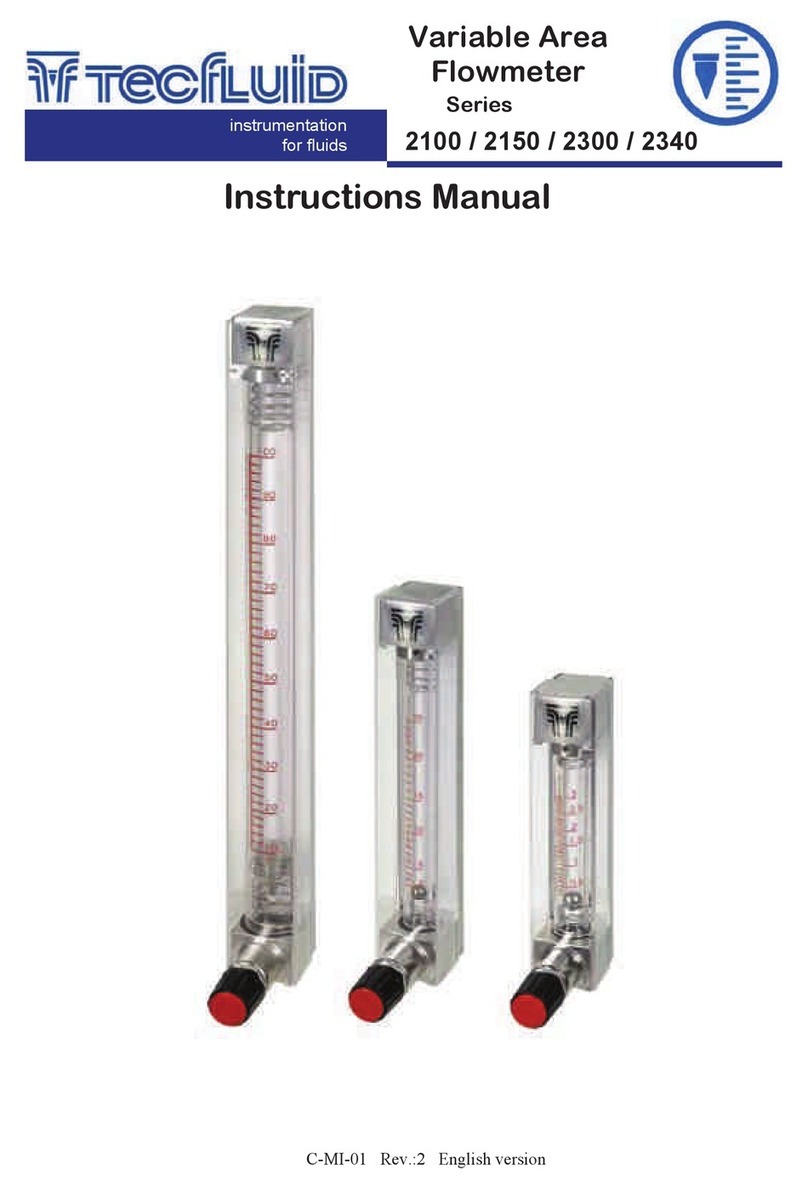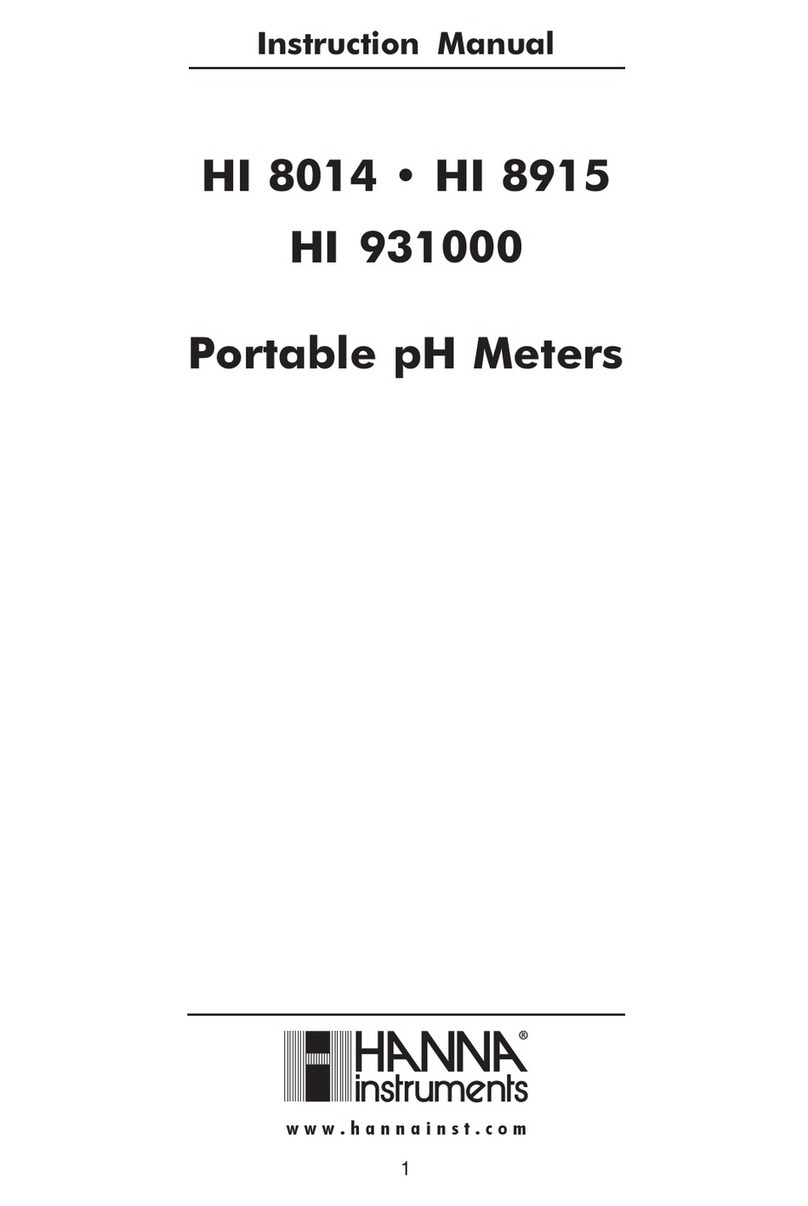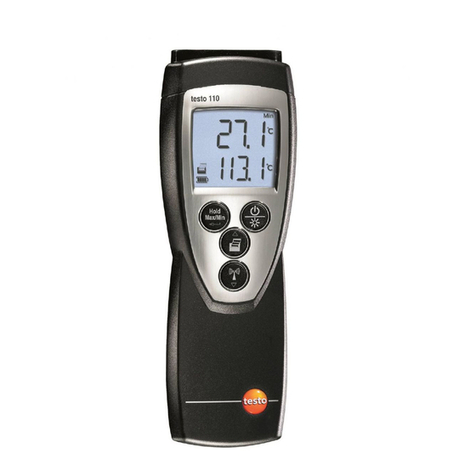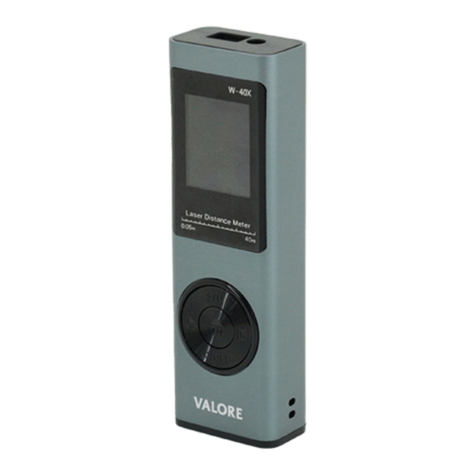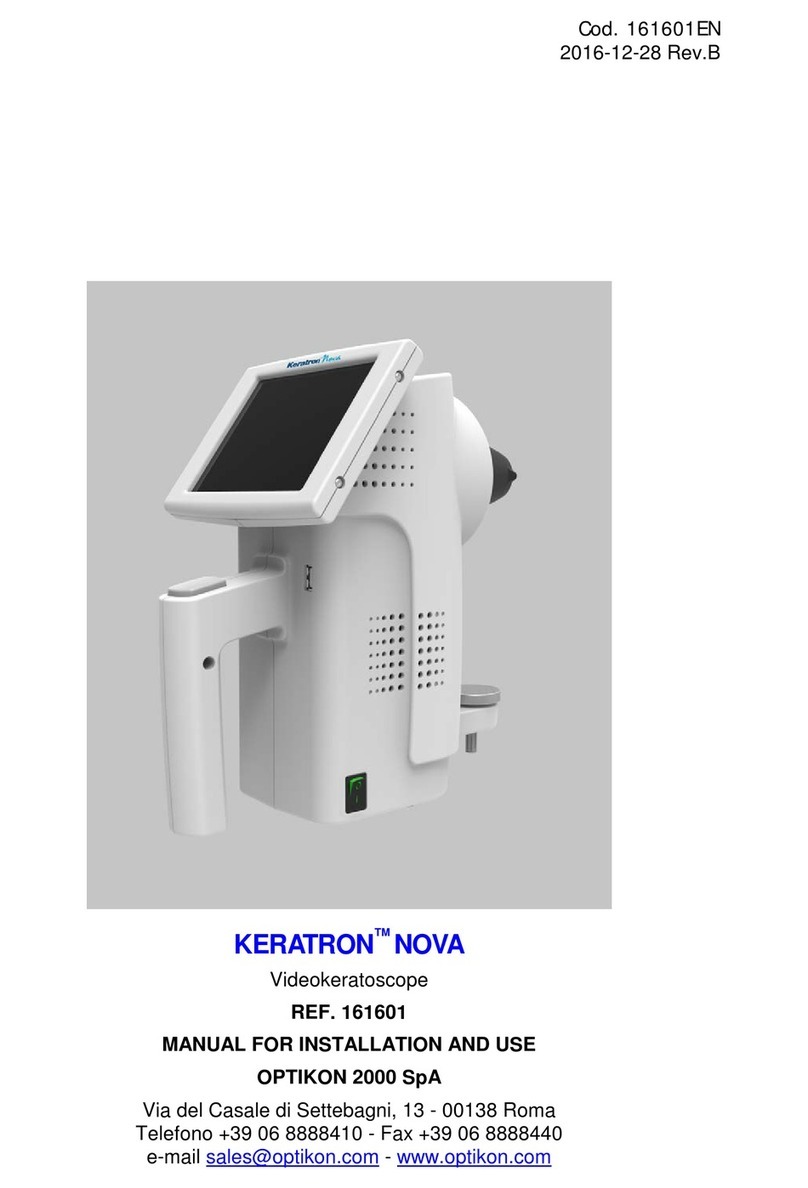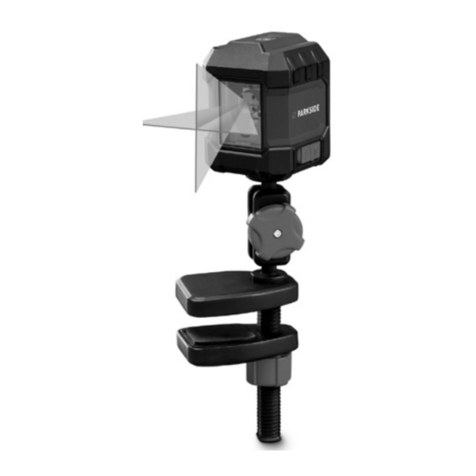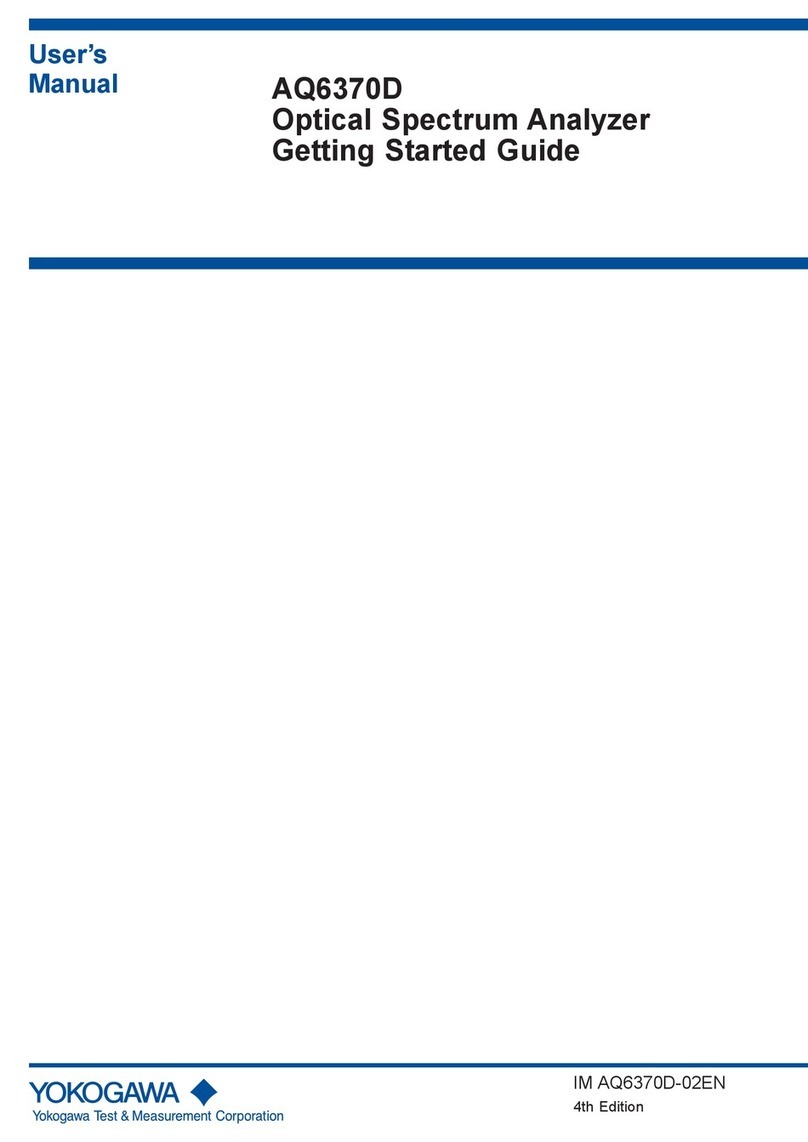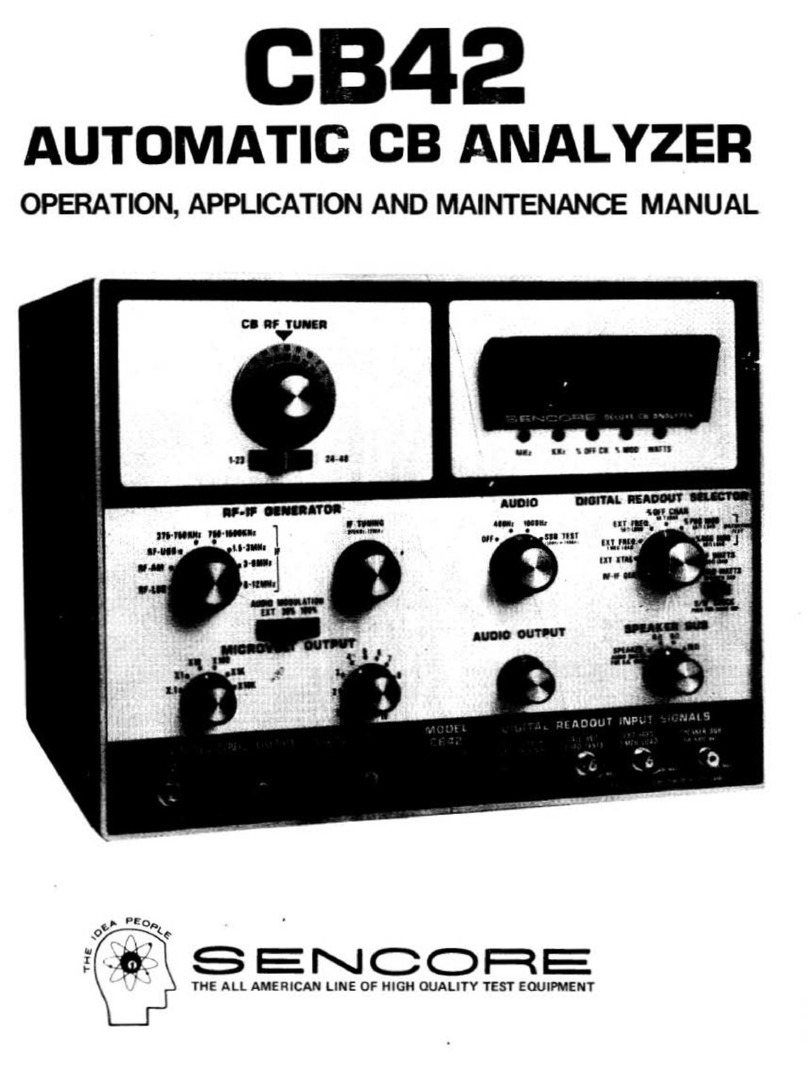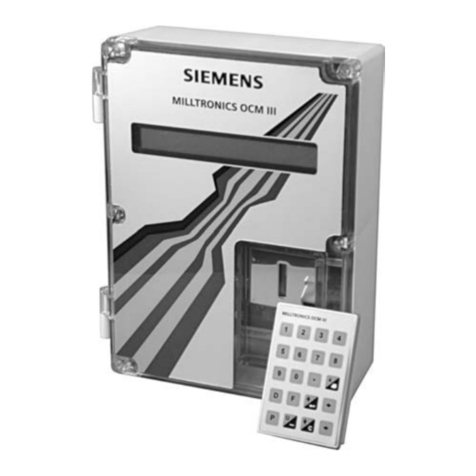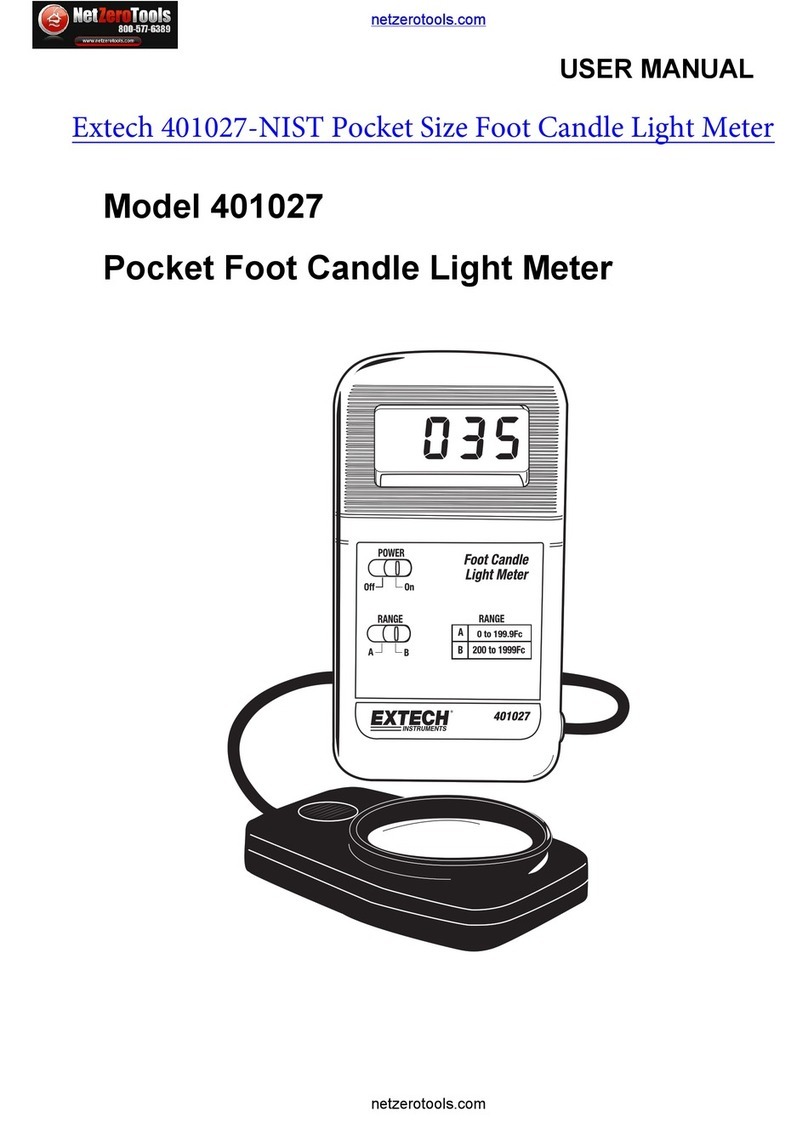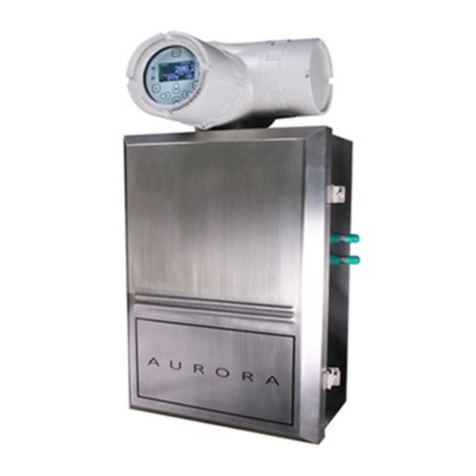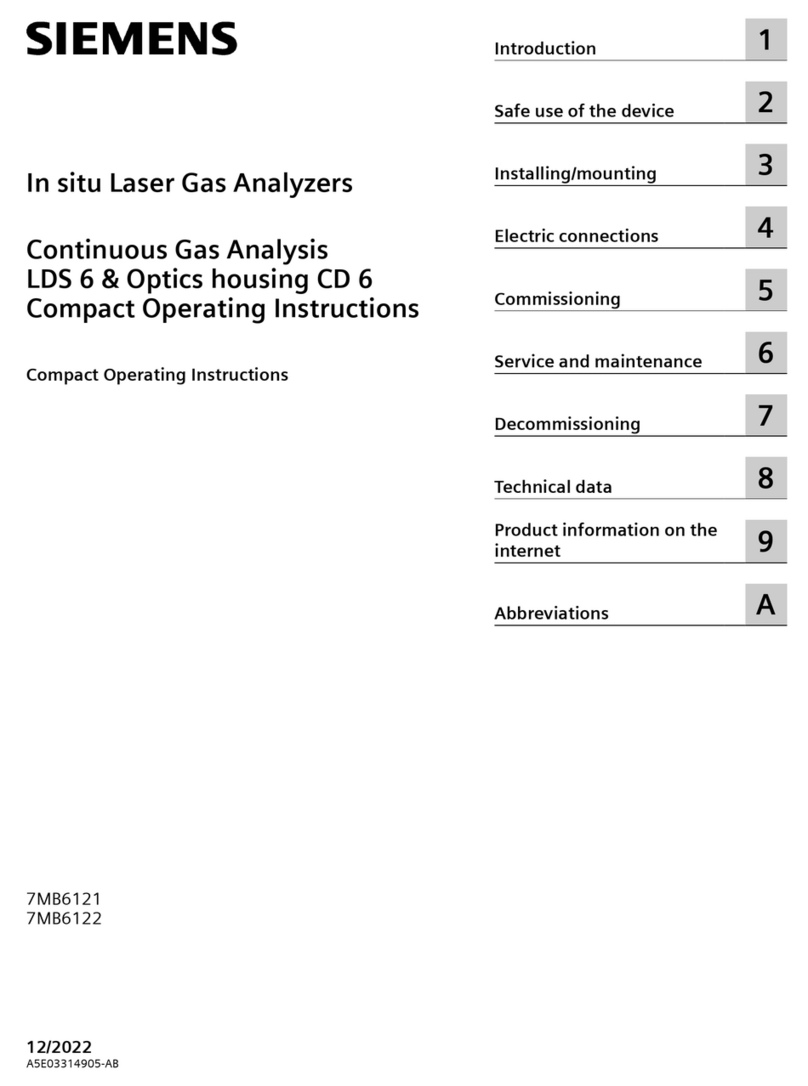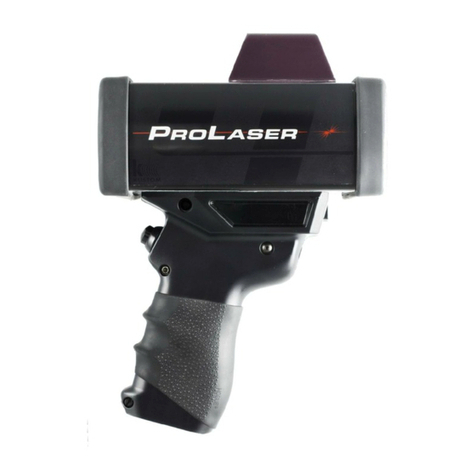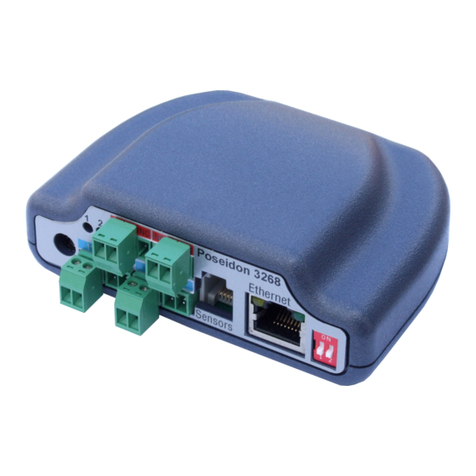Tecfluid LTDR series User manual

Instructions Manual
R-MI-LTDR Rev.: 0 English version
Guided radar
level transmitters
Series LTDR
instrumentation
for fluids

TABLE OF CONTENTS
1 INTRODUCTION ..................................................................................... 3
2 MOUNTING ............................................................................................. 3
2.1 Mounting considerations .......................................................... 4
3 ELECTRICAL CONNECTION !!!..................................................... 5
4 CONTROL ELEMENTS .......................................................................... 6
5 CONFIGURATION SINGLE ROD PROBE AND ROPE PROBE ........... 8
5.1 Perform disturbance signal scan !!!!!!!!!.!........ 8
5.2 Lower range value [4mA]; SPAN 0% !!...!.!.!.!.!....... 8
5.3 Upper range value [20mA]; SPAN 100% !!.!...!.!........... 8
6 CONFIGURATION COAXIAL PROBE ................................................... 9
6.1 Lower range value [4mA]; SPAN 0% !!.!...!.!.!.!........ 9
6.2 Upper range value [20mA]; SPAN 100% !!.!...!.!........... 10
7 PROBE LENGTH AND MEASURING RANGE ...................................... 10
8DISTURBANCE SIGNAL SCAN ............................................................ 11
9ELECTRICAL SPECIFICATIONS .......................................................... 12
10 APPLICATION SPECIFICATIONS ......................................................... 12
11 MEASUREMENT SPECIFICATIONS ..................................................... 13
12 MECHANICAL SPECIFICATIONS ......................................................... 13
13 DIMENSIONS .......................................................................................... 14
14 ADDITIONAL INSTRUCTIONS FOR ATEX VERSION !!!!........... 15
14.1 Electrical data !!.!..!.!.!.................................................. 15
14.2 Temperatures !!.!!!!!!!!!!!!!......!.!........ 15
14.3 Dimensions !!!!!!!!!!!!!!!!!!..!!...! 15
2

1 INTRODUCTION
The LTDR series are 4-wire TDR-Sensors (time domain reflectometry), also known as
Guided Radars or Guided Wave Radars, with single rod, coaxial probe or rope probe for
continuous level measurement and point level detection in liquids, with analog and
switching output.
This document gives instructions for mounting, wiring, and basic configuration of LTDR.
2 MOUNTING
LTDR is mounted vertically to the tank via its connection thread, which is screwed directly
into a standard threaded tank connection, i.e. weld-in socket, or it can be screwed into a
flange, which is then connected to a tank nozzle.
LTDR should not be welded directly into the tank. Neither should flanges be welded onto
LTDR. Welding on the metal parts of LTDR will cause serious damage to the sensor.
Do not lift or handle LTDR by its probe; this can cause excessive stress on the probe
connection. LTDR should be handled by the hexagon or the lower section of the housing.
Do not screw in LTDR by its housing; it should be tightened only via its hexagon (wrench
size 32 mm for connection thread G3/4A).
Tighten the coaxial probe only at its lower hexagon; the upper hexagon of the coaxial
probe is not needed for mounting.
The customer has to ensure proper sealing of the sensor connection; based on his
process conditions like temperature, pressure and resistance against his process liquids
and atmosphere.
G thread connections require a suitable gasket for pressure-tight joints.
The G3/4A connection thread of LTDR is supplied with a gasket made of Klingersil C-
4400, thickness 2 mm. The suggested tightening torque for this thread size, this type of
gasket, and a process pressure of max. 40bar is 25Nm (maximum permissible torque: 45
Nm).
For NPT thread connections, pressure-tight joints require a sealant directly on the
threads.
3
Figure 1. Mounting

2.1 Mounting considerations
The probes should be installed so that they are not directly impacted by liquids flowing out
of the filling inlet. The probe have to be installed as far as possible from the exit tank
drains because the suction effect could damage the probe.
The single rod and rope probes should neither touch nor sway towards other objects
inside the tank or the tank/nozzle walls; e.g. by agitator swirls. In applications with very
strong fluid movements, which can also cause excessive lateral force on the probe, it is
recommended to fix the probe. The anchoring fixtures are customer supplied.
The coaxial probe can be fixed to the tank wall by lateral brackets attached to the tank
wall. Alternatively, a piece of tube attached to the tank bottom can serve as a socket for
holding the end of the coaxial probe in place. In this case proper drainage of the socket
has to be ensured. Any probe fixtures should only guide the probe and not tightly fixed it
to enable movement due to thermal expansion.
4
The single rod and the rope probe are suitable for a very wide range of applications and
liquids, but the signal has a wider detection radius around the rod or cable. Thus, they are
more responsive for measurement signal disturbances which can be easily overcome by
observing a few mounting considerations (see figure 1) and making simple configuration
adjustments to the sensor; in most cases it is enough to activate and utilize the powerful
disturbance signal suppression features of LTDR. However, those work most efficiently on
stationary interference targets like tall and narrow nozzles or close-by objects. In case that
non-stationary interference targets close to the single rod probe, like slowly rotating
agitator blades, cause problems with the measurement, it is recommended to use the
coaxial probe.
In any case, the single rod probe and the rope probe should never get in direct contact
with the tank/nozzle wall or other objects in the tank.
The coaxial probe does not have restrictions regarding mounting position, tank
connection, and proximity to the tank wall or other objects inside the tank.
Figure 2: mounting considerations
- = no restrictions
1enough diameter to fit in the coaxial tube (Ø17,2mm)
2enough diameter to fit in the coaxial tube (Ø17,2mm) and enough room around the
probe for the liquid to flow in and out of the bypass chamber / stilling well
SINGLE ROD AND ROPE PROBE
COAXIAL PROBE
nozzle diameter -1>50mm
nozzle height - <300mm
clearance to tank wall or other internal objects - >100mm
clearance between probe end and tank bottom - >2mm
diameter of bypass chamber / stilling well -2>25mm

The coaxial probe is recommended for installing LTDR into a non-metallic tank or open
pit. If that is not possible, a single rod probe can be used when LTDR is mounted into at
least a DN50 metal flange or screwed into a metal sheet with at least Ø150 mm.
3 ELECTRICAL CONNECTION
Verify that the power supply for the sensor (not supplied) is switched off.
Establish an equipotential connection (potential equalization) between the external earth
terminal of LTDR and the closest ground potential terminal of the tank.
Open the housing cover by turning it counterclockwise.
The housing is supplied with two cable glands M16x1,5 apt for cables of Ø 3,5 ... 10 mm.
Loosen the cable gland and pull the cable through the cable gland into the housing. Pull it
far enough to have a convenient length for stripping and handling the cable.
Install cable with a drip loop outside the housing where the bottom of the loop must be
lower than the cable entry of the housing.
Dismantle the cable carefully and strip the wires as indicated on the top right drawing of
thre figure 3.
The stripped wire ends are connected to the sensor electronic via the green screwless,
cage clamp terminal block. It can accommodate stranded and solid wires 0,5•2 mm².
The usage of cable end sleeves with insulation collar is not recommended.
Simply press an orange lever straight down with a small flat tip screwdriver, insert a
stripped wire end into the terminal hole, and release the orange lever; the wire is now
connected.
The upper sticker inside the housing illustrates the inputs and outputs. Connect all wires
accordingly, as indicated in figure 3.
5
Figure 3. Electrical connection

The DIP switch has 8 small white levers. Small numbers from 1 to 8 are printed
underneath the levers: they indicate the DIP switch positions and correspond to the ones
in figure 5.
The upper position of a lever is off/0 and the lower position is on/1. On the left side of the
DIP switch is also a small indication of the on/1 state.
The off/0 and on/1 states of the DIP switch correspond to the 0/1 indications in figure 5.
The upper sticker on the black plastic cartridge shows three colour segments close to the
DIP switch: red, gray, and blue; they correspond to the coloured rows in figure 5.
6
Pull the cable back, but make sure its mantle does not retract into the cable gland.
Tighten the cable gland to ensure proper sealing function.
Switch on the power supply for the sensor.
The sensor LED should start blinking green within 6 seconds after connecting the power
(during this start-up time the LED is off). The blinking green LED indicates that the sensor
is in measuring mode and working correctly.
Do not tighten the housing cover yet. Some basic configuration is still to be done!
LTDR"s electronic is galvanically completely insulated from its inputs/outputs and the tank
potential; thus avoiding any problems from electrochemical corrosion protection of the
tank.
4 CONTROL ELEMENTS
Basic configuration of LTDR can be done directly on the device via three control
elements: a DIP switch, a single push button and a LED for visual feedback. All settings
required to get LTDR fully operational can be performed directly on the device; or LTDR
can be ordered completely pre-configured.
All three control elements are enclosed in the black plastic cartridge inside the housing.
Figure 4. Control elements

7
x red: indicates DIP switch position 8 which switches between measuring and
configuration mode. Only when DIP switch position 8 is on/1, LTDR can be
configured; configuration mode is indicated by the LED blinking alternately green and
red.
When DIP switch position 8 is off/0, LTDR is in measuring mode; indicated by the
LED blinking green.
It is only possible to enter the configuration mode when DIP switch positions 1 to 7
are off/0 before setting DIP switch position 8 to on/1; otherwise the LED is blinking red
to indicate an error
x blue: indicates the DIP positions through which groups of functions are selected, e.g.
all functions related to the analog current output or the switching output
DIP SWITCH SETTINGS DESCRIPTION
0 0 0 0 0 0 0 0 measuring mode
0 0 0 0 0 0 0 1 configuration mode
FUNCTION GROUP 1 ANALOG CURRENT OUTPUT
0 0 0 1
0 0 1 1
lower range value [4mA]; span 0%
0 0 1 0 upper range value [20mA]; span 100%
0 1 0 0 response time 0,5s (default)
0 1 0 1 response time 2s
0 1 1 0 response time 5s
FUNCTION GROUP 2 SWITCHING OUTPUT
0 0 1 0
0 1 0 1
lower threshold
0 0 1 1 upper threshold
0 1 0 0 NC
0 1 1 0 NO
FUNCTION GROUP 3 DISTURBANCE SIGNAL SUPPRESSION
0 0 0 1
0 1 1
perform disturbance signal scan
0 0 1 0 disturbance signal scan: utilize (default)
0 0 1 1 disturbance signal scan: do not utilize
0 1 0 0
upper dead band: short (default)
single rod probe 30mm1
coaxial probe 0mm1
0 1 0 1
upper dead band: medium
single rod probe 190mm1
coaxial probe 160mm1
0 1 0 0
upper dead band: long
single rod probe 390mm1
coaxial probe 360mm1
1 0 0 0 amplitude threshold: low (default)
1 0 0 1 amplitude threshold: medium
1 0 1 0 amplitude threshold: high
1 1 0 0 coaxial probe
1 1 0 1 Single rod probe
FUNCTION GROUP 4 RESET
0 0 0 1 1 0 0 1 reset to delivery configuration
FUNCTION GROUP 5 MEASURE PROBE LENGTH
0 0 0 1 1 0 1 1 measure probe length
1
DIP SWITCH POSITION
1 2 3 4 5 6 7 8
Figure 5. DIP switch settings
1Always measured from the referente point: sealing surface of the connection thread. See figure 10

8
x gray: indicates the DIP positions through which individual functions/configuration
settings are selected
After setting all DIP switch positions to represent the 0/1 sequence of the desired function
(as described in figure 2), the push button has to be pressed to execute the desired
function. Execution of the function is indicated by the LED remaining green until the
function has been properly executed, in which case the LED returns to blinking alternately
green and red.
5 CONFIGURATION SINGLE ROD PROBE AND ROPE PROBE
For most applications, executing the three basic configuration steps below is sufficient to
achieve a fully functional sensor; providing a continuous level measurement through its
analog current output.
5.1 Perform disturbance signal scan
x LTDR has to be mounted in its final position and the tank has to be completely empty in
order to perform a disturbance signal scan
x set the DIP switch positions to the 0/1 sequence in figure 6. Start from position 8 and
move towards position 1.
x Press the push button.
x LED will remain green briefly while the lower range value setting is being executed.
x Once it has been executed successfully, the LED will return to blinking alternately green
and red.
5.3 Upper range value [20mA]; SPAN 100%
x Raise the liquid inside the tank up to the level where you want to position the upper
range value [20mA]; span 100%.
x LED will blink alternately green and red.
x Press the push button.
x LED will remain green for a few seconds while the disturbance signal scan is being
performed.
x Once the scan is completed successfully, the LED will return to blinking alternately
green and red.
5.2 Lower range value [4mA]; SPAN 0%
x Fill the liquid into the tank up to the level where you want to position the lower range
value [4mA]; span 0%.
x It is recommended that the lower range value stays within the measuring range [M].
x Change DIP switch position 6 to off/0.
DIP SWITCH POSITION
1 2 3 4 5 6 7 8
DIP SWITCH SETTINGS DESCRIPTION
0 0 0 1 0 1 1 1 perform disturbance scan
DIP SWITCH POSITION
1 2 3 4 5 6 7 8
DIP SWITCH SETTINGS DESCRIPTION
0 0 0 1 0 0 1 1 lower range value [4mA]; SPAN 0%
Figure 6

9
x Press the push button.
x LED will remain green briefly while the upper range value setting is being executed.
x Once it has been executed successfully, the LED will return to blinking alternately green
and red.
x Set all the DIP switch positions to 0 as indicated in figure 7. Start from position 1 and
move towards position 8.
x the LED will change to blinking green
Tighten the housing cover properly by turning it clockwise.
6 CONFIGURATION COAXIAL PROBE
The coaxial probe has a very robust and reliable measurement performance in almost any
application without further configuration. For basic configuration only the range values for
the analog current output have to be set.
6.1 Lower range value [4mA]; SPAN 0%
x Set the DIP switch positions to the 0/1 sequence in figure 8. Start from position 8 and
move towards position 1.
x It is recommended that the upper range value stays within the measuring range [M]
(see figure 10).
x Change DIP switch position 3 to on/1.
x Fill the liquid into the tank up to the level where you want to position the lower range
value [4mA]; span 0%.
x It is recommended that the lower range value stays within the measuring range [M] (see
figure 10).
x Press the push button.
DIP SWITCH POSITION
1 2 3 4 5 6 7 8
DIP SWITCH SETTINGS DESCRIPTION
0 0 1 0 0 0 1 1 upper range value [20mA]; SPAN 100%
DIP SWITCH POSITION
1 2 3 4 5 6 7 8
DIP SWITCH SETTINGS DESCRIPTION
0 0 0 0 0 0 0 0 measuring mode
DIP SWITCH POSITION
1 2 3 4 5 6 7 8
DIP SWITCH SETTINGS DESCRIPTION
0 0 0 1 0 0 1 1 lower range value [4mA]; SPAN 0%
Figure 8
Figure 7

10
x the LED will change to blinking green.
Tighten the housing cover properly by turning it clockwise.
7 PROBE LENGTH AND MEASURING RANGE
According with the figure 10, the reference point for definition of the probe length [L] is
always the sealing surface of the connection thread. The probe length [L] is an important
mechanical dimension which is needed to make sure the probe physically fits into the tank
at the anticipated mounting location; it is not equal to the actual measuring range [M] of
the sensor!
LTDR level sensors have small inactive areas at top [I1] and bottom [I2] of the probe.
Those are due to the presence of unavoidable signal disturbances at both ends of the
probe. In these inactive areas the measurements are non-linear or have reduced
accuracy. Therefore, it is not recommended to actually measure level within those inactive
areas. Their length depends on the probe type and the reflectivity (i.e. dielectric constant)
of the liquid to be measured.
The measuring range [M] of LTDR extends between the top and bottom inactive areas of
the probe; this is the area in which LTDR will have the specified measurement
performance. It is recommended that the maximum and minimum liquid levels to be
measured in the tank are actually within the measuring range [M] of the sensor. The span
x LED will remain green briefly while the lower range value setting is being executed.
x Once it has been executed successfully, the LED will return to blinking alternately green
and red.
6.2 Upper range value [20mA]; SPAN 100%
x Raise the liquid inside the tank up to the level where you want to position the upper
range value [20mA]; span 100%.
x It is recommended that the upper range value stays within the measuring range [M]
(see figure 10).
x Change DIP switch position 3 to on/1.
DIP SWITCH POSITION
1 2 3 4 5 6 7 8
DIP SWITCH SETTINGS DESCRIPTION
0 0 1 0 0 0 1 1 upper range value [20mA]; SPAN 100%
DIP SWITCH POSITION
1 2 3 4 5 6 7 8
DIP SWITCH SETTINGS DESCRIPTION
0 0 0 0 0 0 0 0 measuring mode
Figure 9
x Press the push button.
x LED will remain green briefly while the upper range value setting is being executed.
x Once it has been executed successfully, the LED will return to blinking alternately green
and red.
x Set all the DIP switch positions to 0 as indicated in figure 9. Start from position 1 and
move towards position 8.

11
Figure 10. Probe length and measuring range
between the lower range value [4mA] and the upper range value [20mA] of the analog
current output is equal to 0...100% of your continuous level measurement reading. It is
recommended that the span between those two range values stays within the measuring
range [M].
For more details, please consult the section MEASUREMENT SPECIFICATIONS in page
13.
8 DISTURBANCE SIGNAL SCAN
The disturbance signal scan is a powerful disturbance signal suppression feature of
LTDR. The sensor scans its entire probe length for any disturbance signals in the
application that could potentially be misinterpreted as level readings, memorizes and
suppresses them during operation; that way LTDR only recognizes the actual level signals
caused by the liquid to be measured.
The disturbance signal scan is intended for the single rod probe and the rope probe, since
its signal has a wider detection radius around the rod, making it more responsive for
measurement signal disturbances.
The disturbance signal scan works most efficiently on stationary interference targets like
tall and narrow nozzles or close-by objects. Thus, LTDR has to be mounted in its final
position and the tank has to be completely empty in order to perform a disturbance signal
scan; that will ensure a reliable identification of the actual disturbance signals only. In
case that non-stationary interference targets close to the single rod probe, like slowly
rotating agitator blades or streams of liquid being filled into the tank, cause problems with
the measurement, it is recommended to use the coaxial probe.
Performing a disturbance signal scan is the prerequisite for utilizing this feature of LTDR.

12
9 ELECTRICAL SPECIFICATIONS 4-wire system
Output functions continuous level measurement through analog output and
point level detection through switching output
Analog output (active)
current output 4!20 mA
the span between the lower range value [4mA] and the upper range value
[20mA] is equal to 0...100% of the continuous level measurement reading. It
is recommended that the span between those two range values stays within
the measuring range [M] (see figure 10)
Total load resistance
<500 : HARTTM resistor approx. 250+ load resistance approx. 250
if the current output is connected to a device with an inner resistance of
approx. 250 , then there is no additional, external HART resistor necessary.
In that case, the HART modem is connected in parallel to the current output
wires
Lower range value 4,0 mA (span 0%)
Upper range value 20,0 mA (span 100%)
Response time 0,5 s (default), 2 s, 5 s (selectable)
Temperature drift <0,2 mm/K change in ambient temperature
Switching output DC PNP (active) NC or NO (short-circuit protected)
Load current <200mA
Signal voltage HIGH supply voltage - 2 V
Signal voltage LOW 0 V!1 V
Response time <200 ms
Supply voltage 12!30 VDC (reverse-polarity protected)
Current consumption <70 mA at 24 VDC (no burden)
Start-up time <6 s
Cable terminals
screwless, cage clamp terminal block for stranded and
solid wires 0,5!2 mm²
the usage of cable end sleeves with insulation collar is not recommended
10 APPLICATION SPECIFICATIONS continuous level measurement and point level
detection in liquids
Dielectric constant [İr] single rod probe and rope probe: >1,8 coaxial probe:>1,4
Conductivity no restrictions
Density no restrictions
Dynamic viscosity single rod probe and rope probe: <5.000 mPa s = 5.000 cP
coaxial probe: <500 mPa s = 500 cP
Application temperature -40°C!+150°C
Ambient temperature operation: -25°C!+80°C storage: -40°C!+85°C
Application pressure -1bar...40 bar
Velocity of level change <1.000 mm/s
Interface (e.g. oil on top of water)
an oil layer of <70mm thickness on top of water is not detected by the sensor;
in this case the sensor will detect only the water level at a slightly lower posi-
tion than actual. From an oil layer thickness >70mm onwards, the sensor
detects the total level, including the oil layer, according to specifications

11 MEASUREMENT SPECIFICATIONS reference condition: dielectric constant [İr]=80,
water surface, tank Ø1m, DN200 metal flange
13
Accuracy ±3 mm
Repeatability <2 mm
Resolution <1 mm
Probe type
single rod Ø6 mm
coaxial Ø17,2 mm (standard tube: NPS Ǫ", 10S)
rope probe Ø4 mm or Ø6 mm
Probe length [L]
single rod probe: 100...3.000 mm longer length on request
coaxial probe: 100!6.000 mm
rope probe: 1.000...20.000 mm
can be ordered in 1mm increments
the reference point is always the sealing surface of the connection thread (see
dimensional drawings)
Inactive area top [I1]
single rod probe, İr=80: 50 mm single rod probe, İr=2: 80 mm
coaxial probe, İr=80: 30 mm coaxial probe, İr=2: 50 mm
rope probe, İr=80: 80 mm rope probe, İr=2: 80 mm
Inactive areas bottom [I2]
single rod probe, İr=80: 10 mm single rod probe, İr=2: 50 mm
coaxial probe, İr=80: 10 mm coaxial probe, İr=2: 50 mm
rope probe, İr=80: 20 mm rope probe, İr=2: 80 mm
Measuring range [M]
probe length [L] less both inactive areas at top and bottom [I1 and I2]
in this range LTDR will have the specified measurement performance. It is
recommended that the maximum and minimum liquid levels to be measured in
the tank are actually within the measuring range [M] of the sensor (see figure
10)
Switching point [S]
freely positionable within the measuring range [M]
hysteresis can be set by defining separate upper and lower thresholds; if those
are set at the same position, the minimum hysteresis of 3 mm applies
12 MECHANICAL SPECIFICATIONS
Material exposed to
tank atmosphere
single rod probe and rope probe: 1.4404 / 316L and PEEK
coaxial probe: 1.4404 / 316L, PEEK and o-ring seal: EPDM or FKM (Viton)
other o-ring materials on request
gasket at connection thread G3/4A: Klingersil C-4400, 2mm thick
Housing materials
housing body and cover: painted aluminium alloy (epoxy coated in the ATEX
version). Other materials on request
cover o-ring seal: NBR or silicone rubber. Other o-ring materials on request
Housing rating
IP68 10 m H2O, NEMA6P
device cover has to be properly tightened and IP68 screw plugs and cable
glands have to be properly mounted (with sealing) and have to be properly
tightened around cable of suitable type and diameter
Cable entries 2 cable entries M16x1.5
ATEX version: 2 cable entries M20x1.5 other dimensions on request
Connection thread [CT] G¾A (wrench size 32mm) other connection threads on request
Weight
housing, assembled with electronics and feedthrough: 1240 g
housing (empty): 940 g
ATEX housing, assembled with electronics and feedthrough: 950 g
ATEX housing (empty): 650 g
electronics: 70 g
feedthrough: 220 g
single rod probe, 1m: 230 g
complete coaxial probe, 1m: 770 g coaxial tube (not assembled), 1m: 540 g
set of parts for attaching coaxial tube: 130 g

14
Conforms with the 2002/96/CE Directive
Conforms with the 2004/108/CE Directive
Conforms with the 97/23/CE Directive
This equipment is considered as being a pressure accessory and NOT a safety
accessory as defined in the 97/23/CE directive, Article 1, paragraph 2.1.3.
13 DIMENSIONS
Rope
probe
Coaxial
probe
Single rod
probe

15
14 ADDITIONAL INSTRUCTIONS FOR ATEX VERSION
The LTDR is suitable for applications with hazardous gas or dust atmospheres, for
applications requiring instruments of category 1/2G, 1/2D or 2G, 2D.
If the LTDR is installed and operated in hazardous areas, the general hazardous area
installation regulations IEC 60079-14, all relevant national, regional and local regulations
and standards, as well as these safety instructions must be observed.
The installation of electrical equipment in hazardous areas must always be carried out by
qualified personnel.
The approval certificate is the following: 0158 SEV 09 ATEX 0171 X
and the different markings:
II 1/2G Ex ia/d IIC T6 II 1/2G Ex ia/d IIC T6 Ga/Gb
II 1/2D Ex iaD/tD A20/21 IP68 T86°C II 1/2D Ex ia/t IIIC T86°C Da/Db
II 2G Ex ia d IIC T6 II 2G Ex ia d IIC T6 Gb
II 2D Ex iaD tD A21 IP68 T86°C II 2D Ex ia t IIIC T86°C Db
14.1 Electrical data
Power supply (terminals 1 and 2): U = 12!30V DC Um= 250 VAC
Analog output (terminals 3 and 4): I = 4!20mA Um= 250 VAC
Switching output (terminals 5 and 6): Us= 0!U Um= 250 VAC
14.2 Temperatures
CATEGORY 1/2G
Temperature class Application
temperature Ambient temperature
T1...T6 -20!+60°C -40!+70°C
CATEGORY 2G
T6 -40!+85°C -40!+70°C
T5 -40!+100°C -40!+70°C
T4 -40!+135°C -40!+70°C
T1!T3 -40!+150°C -40!+70°C
CATEGORY 1/2D Y 2D
Max. sup. temperature: +86°C -40!+70°C
14.3 Dimensions
Earth terminal
Cover locking screw

TECFLD, S.A.
Narcís Monturiol, 33
E-08960 Sant Just Desvern
Tel. + 34 93 3724511 - Fax + 34 93 4734449
E-mail:uidt
Internet: www.teluid.com
The technical data in this document is subject to modification without notification, if the technical innovations in the product or
manufacturing processes so require.
TECFLUID
B.P. 27709
95046 CERGY PONTOISE CEDEX - FRANCE
Tel. 00 33 1 34 64 38 00 - Fax. 00 33 1 30 37 96 86
internet : www.tecfluid.frECFLUID
B.P. 27709
WARRANTY
TECFLUID guarantees all the products for a period of 24 months from their sale, against all
faulty materials, manufacturing or performance. This warranty does not cover failures which
might be imputed to misuse, use in an application different to that specified in the order, the
result of service or modification carried out by personnel not authorized by Tecfluid, wrong
handling or accident.
This warranty is limited to cover the replacement or repair of the defective parts which have
not damaged due to misuse, being excluded all responsibility due to any other damage or the
effects of wear caused by the normal use of the devices.
Any consignment of devices for repair must observe a procedure which can be consulted in
the website www.tecfluid.fr, "After-Sales" section.
All materials sent to our factory must be correctly packaged, clean and completely exempt of
any liquid, grease or toxic substances.
The devices sent for repair must enclose the corresponding form, which can be filled in via
website from the same "After-Sales" section.
Warranty for repaired or replaced components applies 6 months from repair or replacement
date. Anyway, the warranty period will last at least until the initial supply warranty period is
over.
TRANSPORTATION
All consignments from the Buyer to the Seller's installations for their credit, repair or
replacement must always be done at freight cost paid unless previous agreement.
The Seller will not accept any responsibility for possible damages caused on the devices
during transportation.
Table of contents
Other Tecfluid Measuring Instrument manuals
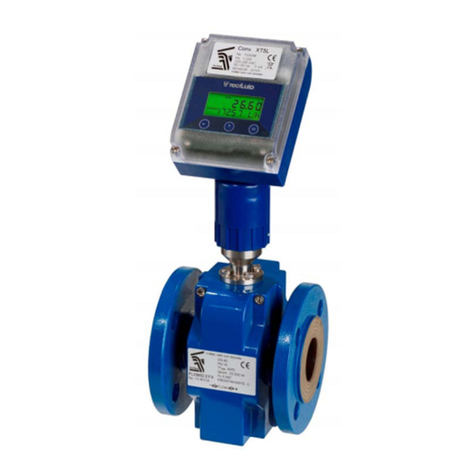
Tecfluid
Tecfluid FLOMID Series User manual
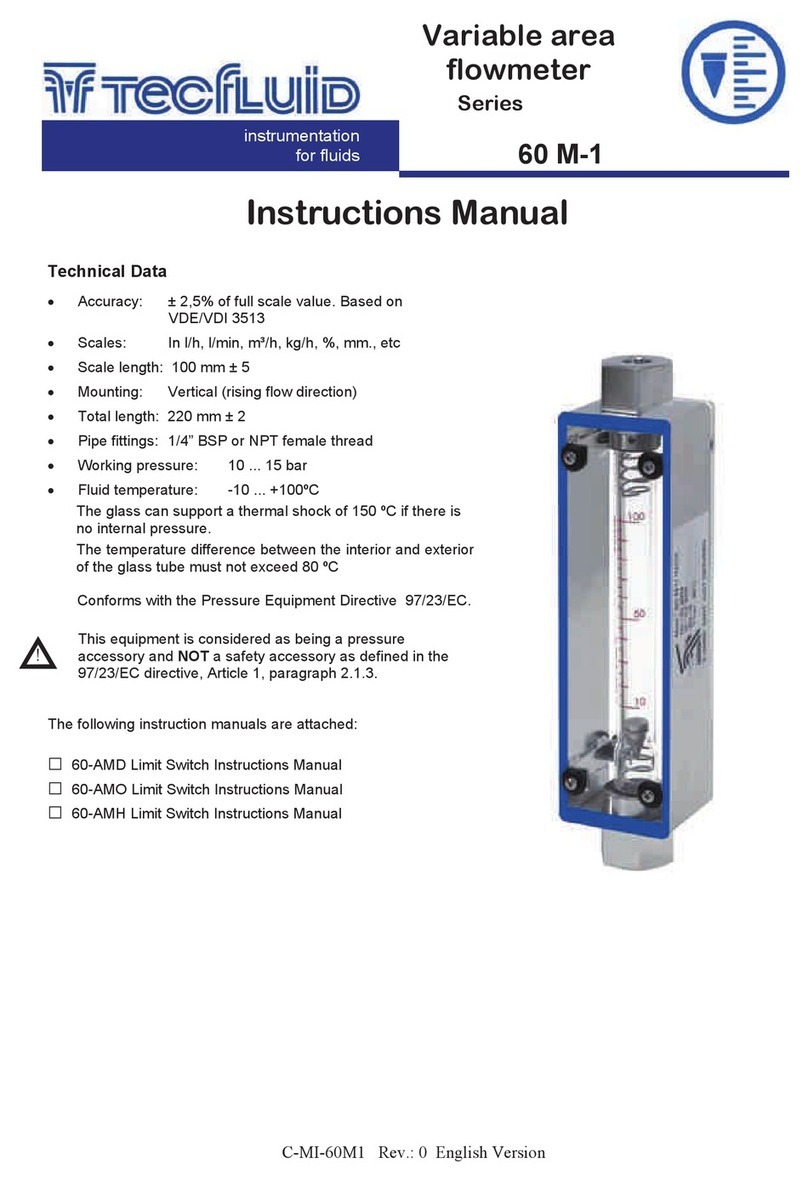
Tecfluid
Tecfluid 60 M-1 Series User manual

Tecfluid
Tecfluid Series LT User manual
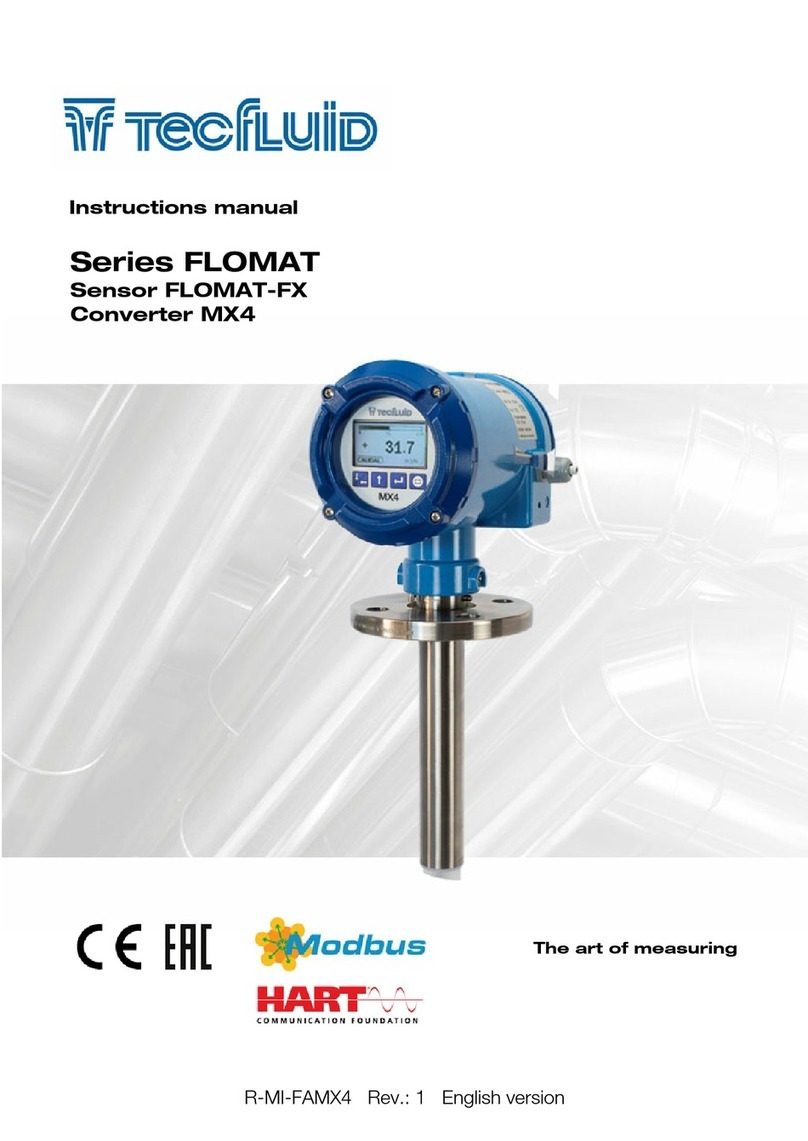
Tecfluid
Tecfluid FLOMAT Series User manual

Tecfluid
Tecfluid CU Series User manual
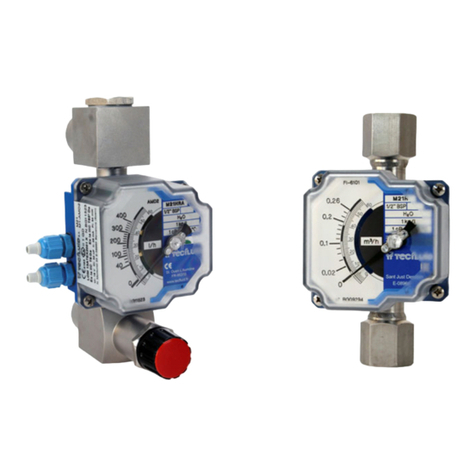
Tecfluid
Tecfluid M21 User manual
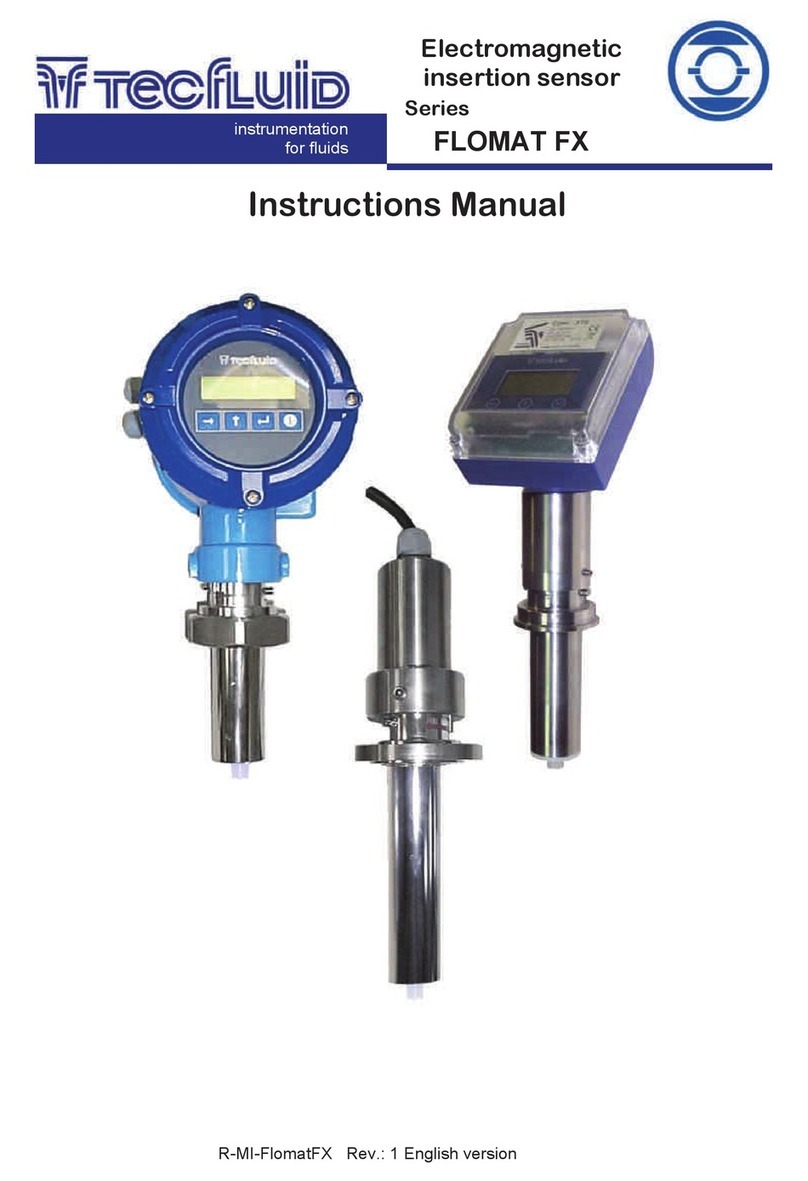
Tecfluid
Tecfluid FLOMAT FX FlomatFX User manual

Tecfluid
Tecfluid LS Series User manual

Tecfluid
Tecfluid AD Series User manual

Tecfluid
Tecfluid FLOMID Series User manual
